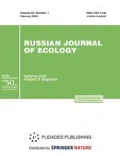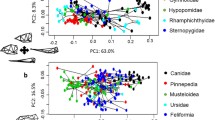Abstract
An evolutionary-ecological analysis of homologous variations in cranial morphological structures (phenes) has been performed at the level of populations and subspecies exposed to technogenic, climatic, and landscape-geographic changes in the environment, as well as with ecological series of 46 species and infraspecific forms differing in ecological specialization within the family Cricetidae. On this basis, consistent manifestations of phenogenetic variation have been revealed. Species with the same ecological specialization show parallel directional changes in the frequencies of homologous phenes and their individual combinations. These changes apparently have adaptive significance and result from rearrangements in the ancestral epigenetic system. It is shown that similar ecological requirements imposed by the environment historically lead to unidirectional transformations of homologous morphological structures in different species, which may account for high incidence of homoplasy as well as for the parallel and, in part, directional evolution of closely related taxa with similar ecological specialization.
Similar content being viewed by others
References
Astaurov, B.L., Nasledstvennost’ i razvitie (Heredity and Development), Moscow: Nauka, 1974.
Berry, R.J. and Searle, A.G., Epigenetic Polymorphism of the Rodent Skeleton, Proc. Zool. Soc. London, 1963, vol. 140, pp. 557–615.
Fadeeva, T.V. and Smirnov, N.G., Melkie mlekopitayushchie Permskogo Predural’ya v pozdnem pleistotsene i golotsene (Small Mammals of the Perm Cisural Region in the Late Pleistocene and Holocene), Yekaterinburg: Goshchitskii, 2008.
Gilbert, S.F., Evo-Devo, Devo-Evo, and Devgen-Popgen, Biol. Philos., 2003, vol. 18, pp. 347–352.
Gilbert, S.F., Opitz, J.M., and Raff, R.A., Resynthesizing Evolutionary and Developmental Biology, Dev. Biol., 1996, vol. 173, pp. 357–372.
Hammer, Ø., Harper, D.A.T., and Ryan, P.D., PAST: Paleontological Statistics Software Package for Education and Data Analysis, Palaeontol. Electron., 2001, vol. 4, no. 1.
Korona, V.V. and Vasilyev, A.G., Stroenie i izmenchivost’ list’ev rastenii: Osnovy modul’noi teorii (Structure and Variation of Plant Leaves: Fundamentals of the Modular Theory), Yekaterinburg: Yekaterinburg, 2000.
Krenke, N.P., Phenogenetic Variation, Tr. Biol. Inst. im. K.A. Timiryazeva, Moscow, 1933–1935, vol. 1.
Meyen, S.V., Problems in Phylogenetic Classification of Organisms, in Sovremennaya paleontologiya: metody, napravleniya, problemy, prakticheskoe prilozhenie: Spr. posob. (A Manual of Modern Paleontology: Methods, Directions, Problems, and Applications), Moscow: Nedra, 1988, vol. 2, pp. 497–511.
Moyne, S. and Neige, P., The Space-Time Relationship of Taxonomic Diversity and Morphological Disparity in the Middle Jurassic Ammonite Radiation, Palaeogeogr. Palaeoclimatol. Palaeoecol., 2007, vol. 248, pp. 82–95.
Pianka, E.R., Evolutionary Ecology, New York: Harper and Row, 1978. Translated under the title Evolyutsionnaya ekologiya, Moscow: Mir, 1981.
Rautian, A.S., Paleontology As a Source of Information on Patterns and Factors of Evolution, in Sovremennaya paleontologiya: metody, napravleniya, problemy, prakticheskoe prilozhenie: Spr. posob. (A Manual of Modern Paleontology: Methods, Directions, Problems, and Applications), Moscow: Nedra, 1988, vol. 2, pp. 76–118.
Shvarts, S.S., Ekologicheskie zakonomernosti evolyutsii (Ecological Patterns of Evolution), Moscow: Nauka, 1980.
Smirnov, N.G., Dynamics of Species and Species Complexes as a Field of Research in Historical Ecology, Ekologiya, 2006, no. 6, pp. 452–456.
Strunnikov, V.A. and Vyshinskii, I.M., Realizational Variation in the Silkworm, in Problemy genetiki i teorii evolyutsii (Problems in Genetics and the Theory of Evolution), Novosibirsk: Nauka, 1991, pp. 99–114.
Tatarinov, L.P., Parallelisms and Directionality in Evolution, in Evolyutsiya i biotsenoticheskie krizisy (Evolution and Biocenotic Crises), Moscow: Nauka, 1987, pp. 124–144.
Vasilyev, A.G., Epigeneticheskie osnovy fenetiki: na puti k populyatsionnoi meronomii (Epigenetic Foundations of Phenetics: On the Way to Population Meronomy), Yekaterinburg: Akademkniga, 2005.
Vasilyev, A.G., Phenogenetic Variation and Population Meronomy, Zh. Obshch. Biol., 2009, vol. 70, no. 3, pp. 195–209.
Vasilyev, A.G. and Bol’shakov, V.N., Yesterday and PresentDay Views on Evolutionary Ecology, Ekologiya, 1994, no. 3, pp. 4–15.
Vasilyev, A.G. and Vasilyeva, I.A., Non-Metric Variation in Red Vole Populations within the East-Ural Radioactive Track (EURT) Zone, Acta Theriol., 1995, Suppl. 3, pp. 55–64.
Vasilyev, A.G. and Vasilyeva, I.A., Epigenetic Rearrangements in Populations As a Probable Mechanism Providing for the Onset of a Biocenotic Crisis, Vestn. Nizhegorod. Gos. Univ. im. N.V. Lobachevskogo, Ser. Biol., 2005, no. 1 (9), pp. 27–38.
Vasilyeva, I.A., Patterns of Homologous Variation in Morphological Characters of Rodents at Different Stages of Evolutionary Divergence, Extended Abstract of Doctoral (Biol.) Dissertation, Yekaterinburg, 2006.
Vasilyeva, I.A., Vasilyev, A.G., Lyubashevskii, N.M., et al., Phenogenetic Analysis of Pygmy Wood Mouse (Apodemus uralensis Pall.) Populations in the Zone of the Eastern Ural Radioactive Trace (EURT), Ekologiya, 2003, no. 6, pp. 325–332.
Zakharov, V.M., Asimmetriya zhivotnykh: populyatsionnofeneticheskii podkhod (Asymmetry in Animals: A Population-Genetic Approach), Moscow: Nauka, 1987.
Zherikhin, V.V., Izbrannye trudy po paleoekologii i filotsenogenetike (Selected Studies in Paleoecology and Phylocenogenetics), Moscow: KMK, 2003.
Author information
Authors and Affiliations
Corresponding author
Additional information
Original Russian Text © A.G. Vasilyev, I.A. Vasilyeva, V.N. Bol’shakov, 2010, published in Ekologiya, 2010, No. 5, pp. 323–329.
Rights and permissions
About this article
Cite this article
Vasilyev, A.G., Vasilyeva, I.A. & Bol’shakov, V.N. Evolutionary-ecological analysis of trends in phenogenetic variation of homologous morphological structures: From populations to ecological series of species. Russ J Ecol 41, 365–371 (2010). https://doi.org/10.1134/S1067413610050012
Received:
Published:
Issue Date:
DOI: https://doi.org/10.1134/S1067413610050012




